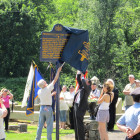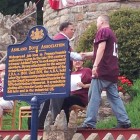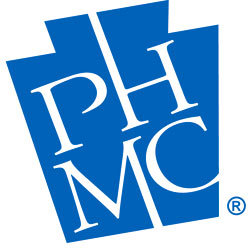The summer of 2013 has been filled with interesting marker dedications. In June The Williamson Free School of Mechanical Trades received a historical marker. This unique institution in Delaware County was founded in 1888 in response to the decline of the apprenticeship system in the late 19th century. Still offering all of its students full scholarships, the institution provides many of its students vocational opportunities they might not otherwise have been able to afford. It served as a model for the Thaddeus Stevens School and Milton Hershey among others, and is credited with establishing the “Williamson Model for Change.” It boasts a beautiful campus rife with original Frank Furness buildings.
 Also in June, the Pennepack Baptist Church, the oldest permanent Baptist church in the Commonwealth, was recognized with a marker in Philadelphia. In a rather unique circumstance, a marker for the Black Boys Rebellion was dedicated in Fort Loudon, Franklin County. A 1955 marker entitled Widow Barr Place had long been missing from this location. With the financial support of the local D.A.R., PHMC was able to revise the title and text of this marker to better reflect the significance of the site and event. The Black Boys Rebellion involved a group of local settlers who conducted raids on British supply shipments in protest of the British negotiations with the Indians. The settlers had been plagued by Indian raids and opposed dealings with the natives. A skirmish occurred on the site of the Widow Barr Place in 1765, which is considered by many to be the first armed resistance to British rule – a precursor to the American Revolution.
Also in June, the Pennepack Baptist Church, the oldest permanent Baptist church in the Commonwealth, was recognized with a marker in Philadelphia. In a rather unique circumstance, a marker for the Black Boys Rebellion was dedicated in Fort Loudon, Franklin County. A 1955 marker entitled Widow Barr Place had long been missing from this location. With the financial support of the local D.A.R., PHMC was able to revise the title and text of this marker to better reflect the significance of the site and event. The Black Boys Rebellion involved a group of local settlers who conducted raids on British supply shipments in protest of the British negotiations with the Indians. The settlers had been plagued by Indian raids and opposed dealings with the natives. A skirmish occurred on the site of the Widow Barr Place in 1765, which is considered by many to be the first armed resistance to British rule – a precursor to the American Revolution.
July saw the dedication of the marker for Scotland School for Veterans’ Children. This 1895 state-run institution was established to provide an education for veterans’ children across the state of Pennsylvania. Most students were either orphans or from single parent families. The school initially focused on providing an education in the trades, as the Pennsylvania Soldiers’ Orphans Industrial School, intended to provide the students with a sense of self-sufficiency. Its curriculum became more traditional in recent years, and the school’s teams achieved notable success in scholastic sports. Among the first state-operated schools for veterans’ children in the nation, at its closing in 2009, it was also the last. Many former students returned for the dedication.
There were four marker dedications in August. Schuylkill County was recognized as “Little Lithuania, USA,” having the largest percentage of Lithuanian heritage within its population of any county in the nation. The marker is located in Shenandoah, but the dedication took place at the Schuylkill Mall in Frackville. The event was part of one of the longest consecutive ethnic celebrations in the country, Lithuanian Days, sponsored by the local Knights of Lithuania chapter. Traditional Lithuanian dances were performed, Lithuanian songs were sung, and of course, delicious Lithuanian dishes were served as part of the celebration.
 The Mason-Dixon Survey celebrated its 250th anniversary this year in Philadelphia, where a marker was dedicated at the starting point of the survey. One of America’s most famous borders, the Mason-Dixon Line separates Pennsylvania and Maryland. It was the traditional line of demarcation between the North and the South during the Civil War. A unique organization was recognized in Ashland, PA, the Ashland Boys’ Association. Established in the early 1900s, the group sponsored annual homecoming events to welcome the many formers miners that dispersed throughout the state and nation when the local anthracite mines began to fail. The ABA also raised money to erect the Mother’s Memorial in the center of town – a prominent landmark. The marker is placed at the base of this impressive monument. The celebration included an address by the current Miss Pennsylvania and a parade through town.
The Mason-Dixon Survey celebrated its 250th anniversary this year in Philadelphia, where a marker was dedicated at the starting point of the survey. One of America’s most famous borders, the Mason-Dixon Line separates Pennsylvania and Maryland. It was the traditional line of demarcation between the North and the South during the Civil War. A unique organization was recognized in Ashland, PA, the Ashland Boys’ Association. Established in the early 1900s, the group sponsored annual homecoming events to welcome the many formers miners that dispersed throughout the state and nation when the local anthracite mines began to fail. The ABA also raised money to erect the Mother’s Memorial in the center of town – a prominent landmark. The marker is placed at the base of this impressive monument. The celebration included an address by the current Miss Pennsylvania and a parade through town.
 The highlight of summer marker dedications had to be that for The Banana Split in Latrobe, PA. David Stricker of Latrobe is credited with creating the first banana split in 1904. The City organized a weekend-long event which featured a sock hop, bubble gum-blowing and limbo contests, a flash mob, a banana baking contest, a song contest, and more. The local St. Vincent’s College was very involved in the event as were local service and community groups. Dole Food Company sponsored the event, donated hundreds of bananas for the celebration, and sent their mascot Bobby Banana to represent the company throughout the weekend. The marker dedication was the kick-off event for the festival, and Latrobe native, Arnold Palmer, participated. The first ever Great American Banana Split Festival received great media coverage and was a rousing success. Judging from the many photos taken throughout the weekend, a great time was had by all.
The highlight of summer marker dedications had to be that for The Banana Split in Latrobe, PA. David Stricker of Latrobe is credited with creating the first banana split in 1904. The City organized a weekend-long event which featured a sock hop, bubble gum-blowing and limbo contests, a flash mob, a banana baking contest, a song contest, and more. The local St. Vincent’s College was very involved in the event as were local service and community groups. Dole Food Company sponsored the event, donated hundreds of bananas for the celebration, and sent their mascot Bobby Banana to represent the company throughout the weekend. The marker dedication was the kick-off event for the festival, and Latrobe native, Arnold Palmer, participated. The first ever Great American Banana Split Festival received great media coverage and was a rousing success. Judging from the many photos taken throughout the weekend, a great time was had by all.

Leave a Reply